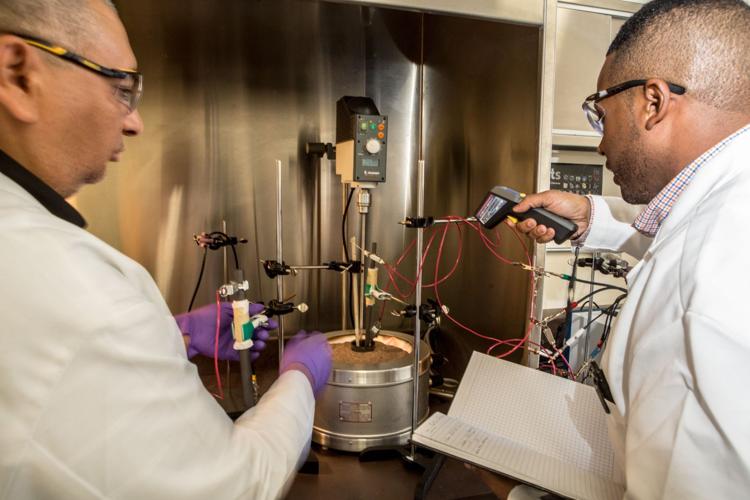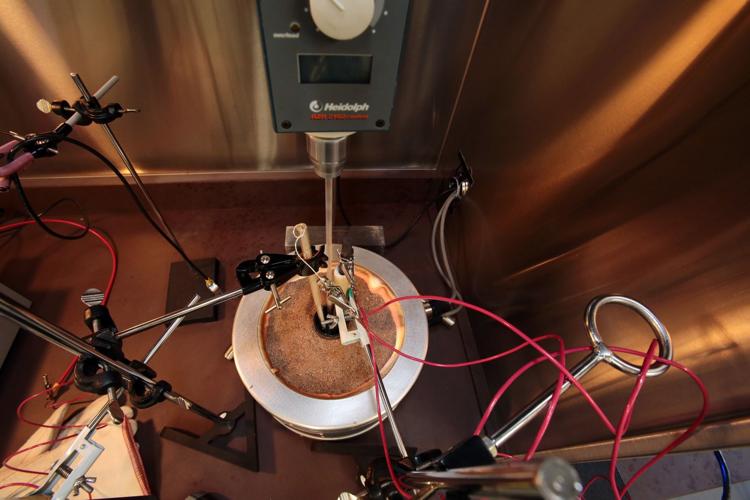Giving birth to invention out of necessity, a group of UA scientists found a new way to combat industrial corrosion — and a new, cleaner method of metals extraction for the mining industry in the bargain.
The work of the University of Arizona’s Dominic Gervasio and his colleagues has led to the launch of two companies, Caltrode and MetOxs, to commercialize the technologies with the help of Tech Launch Arizona.
Caltrode was founded last year to commercialize a new kind of high-temperature sensor to measure corrosion potential in heat-transfer fluids used in industrial applications including thermal solar-power plants.
Gervasio, a professor in the UA department of chemical and environmental engineering, was making progress in research into advanced heat-transfer fluids under a U.S. Energy Department grant a few years ago.
But his research group had trouble finding a corrosion sensor that would work at extremely high temperatures.
“We couldn’t find one, so we made our own,” Gervasio recalled.
Gervasio developed the sensor, known as a reference electrode, for use with the high-temperature molten salts used in thermal solar generators.
He worked with principal research specialist Hassan Elsentriecy of chemical and environmental engineering and Peiwen “Perry” Li of aerospace and mechanical engineering, a longtime energy-technology researcher.
Molten salts, which flow as liquids at high temperatures, are used as a heat-transfer and -storage medium in thermal solar power plants like the 280-megawatt Solana plant near Gila Bend.
The technology also can be used in other applications, including nuclear reactors and oil refining, where working temperatures can top 1,500 degrees Fahrenheit.
With funding from serial entrepreneur and co-inventor Abraham Jalbout, the team worked with Tech Launch Arizona — the office of the UA that commercializes the inventions stemming from university research — to file for patents on the technology and form a startup company, Caltrode, to bring it to market.
The Caltrode electrode measures the potential for so-called galvanic corrosion by monitoring voltage differentials between the pipes and fluids moving through them, allowing engineers to adjust the fluid mix to eliminate or minimize corrosion.
Meanwhile, Jalbout, a Ph.D. physicist, had been working separately with Gervasio to study new formulas for lexiviants — liquids used to selectively extract metal from ores.
“While we were struggling with stopping metals from dissolving, Abe kept asking us to dissolve metal,” Gervasio said.
“So one day the angel of light hit me on the head and said ‘stop fighting it,’ and we said, why don’t we just use these salts to extract the metal?”
Elsentriecy tested the theory, and the molten-salt formula developed by Gervasio and his colleagues worked as a highly efficient metal-extraction tool.
“We’re extracting virtually all the metals out of ores — even out of slag,” Gervasio said.
The new process is similar — but much hotter — than a method commonly used for refining aluminum ore that had not been considered feasible for other metals.
In a scientific paper published by Gervasio, Elsentriecy and Jalbout last year, the scientists showed how they were able to extract more than 98 percent of copper from powdered ore concentrate containing about 20 percent copper.
In another experiment, the researchers used the process to extract 1 gram of copper from 50 grams of mining slag — a byproduct of copper smelting — containing about 2 percent copper.
Even with low-grade concentrates, the research team has achieved extraction rates near 100 percent, said Elsentriecy, a Ph.D. who previously was a postdoctoral research associate at the Oak Ridge National Laboratory.
The company initially has seen very high extraction efficiencies with silver ores, said Jalbout, who got his chemical physics doctorate when he was 18.
Besides efficiency, the technology has other benefits.
Unlike current metals-extraction technologies using potentially hazardous acids and solvents, the MetOxs technology uses no liquid water or volatile chemicals, Gervasio noted.
The MetOxs process uses a relatively benign and recyclable molten-salt mix ofpotassium chloride, sodium chloride — table salt — and zinc chloride.
The environmental benefits could be a major selling point, said Bob Sleeper, a Tech Launch Arizona licensing manager for the UA College of Engineering working with the Caltrode and MetOxs inventors.
“The current technology for copper and metal extraction, it’s kind of insidious, and this replaces that,” said Sleeper, who is helping MetOxs patent the invention.
At the Tucson lab in a small industrial center on North Swan Road, the MetOxs researchers have set up a small test-extraction reactor using its proprietary motion salt and monitored by a reference electrode.
The next step is to build a larger demonstration reactor on-site.
Eventually, Jalbout said, the company hopes to tap into the mining industry in the U.S. and Mexico, designing, engineering and installing custom molten-slat extraction reactors at customer sites.
MetOxs has set up a second lab in Hermosillo, Mexico, where Jalbout has connections in the mining industry through prior businesses.
Jalbout says Caltrode is on a different, perhaps faster path to market.
The high-temp reference electrode has been fully tested and is ready for production, he said. The company is looking for a company to manufacture and distribute the product for MetOxs.
“We want to control the way we develop our product line,” Jalbout said, adding that the company is in talks with several potential manufacturing partners.
Jalbout is also involved in two other ventures with UA faculty members.
One being developed under MetOxs is a technology for “smart panels” — modular, motorized panels designed to float on mine tailing ponds to reduce water loss from evaporation.
That technology, which could include solar cells to generate energy, was co-invented by Moe Momayez, a UA associate professor of mining and geological engineering.
The other venture is Acrete, a company based on a technology that turns fly ash, an industrial waste, into a plastic-like building material. The chemical process was co-invented by Jinhong Xhang, a UA associate engineering professor and the company’s chief technology officer.











